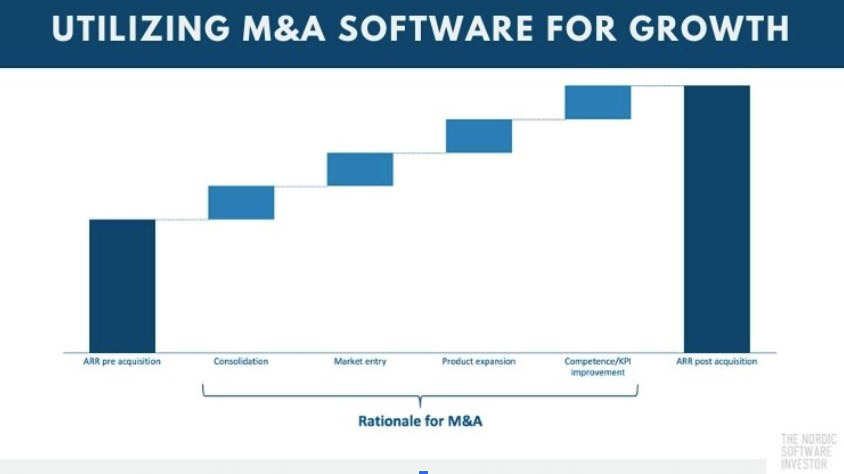Utilize M&A software to unleash growth potential through effective management and integration of acquisitions. In today’s rapidly evolving business landscape, mergers and acquisitions (M&A) have become a strategic imperative for organizations seeking expansion, increased market share, and enhanced competitiveness.
To stay ahead of the curve, businesses need efficient tools that enable seamless integration and effective management of M&A and venture capital activities. M&A software provides a comprehensive solution by streamlining due diligence, financial analysis, and post-merger integration.
By leveraging the power of M&A software and venture capital-specific solutions like dialllog, companies and VC funds can optimize decision-making processes, enhance communication and collaboration, and unlock the full potential of their acquisitions and investment projects. With Dialllog, VC funds can manage their entire investment cycle, ensuring a more organized and streamlined approach to venture capital activities.
This article explores how businesses can leverage M&A software to drive growth and achieve their strategic objectives.
Utilizing M&A Software for Growth: The Importance Of M&A Software
In today’s fast-paced business environment, mergers and acquisitions (M&A) have become a popular strategy for companies looking to expand and stay competitive. However, the success of these endeavors relies heavily on efficient processes and informed decision-making. This is where M&A software comes into play. By leveraging cutting-edge technology, businesses can streamline acquisition processes, enhance due diligence efforts, and improve decision-making abilities.
Streamlining Acquisition Processes
- M&A software automates various tasks, reducing the time and effort required for manual processes.
- It provides a centralized platform for managing and tracking the entire acquisition lifecycle, from initial screening to post-merger integration.
- With built-in workflows and collaboration tools, teams can collaborate more effectively, facilitating communication and minimizing errors.
- Real-time updates and analytics enable stakeholders to monitor progress and make timely adjustments when necessary.
Enhancing Due Diligence Efforts
- M&A software offers comprehensive due diligence tools, enabling businesses to conduct thorough assessments of potential targets.
- By digitizing document management and organizing data in a structured manner, reviewing and analyzing critical information becomes easier.
- Advanced analytics and reporting capabilities provide deep insights into financial, legal, and operational aspects, minimizing the risk of overlooking crucial details.
- Leveraging artificial intelligence and machine learning algorithms, the software can identify patterns and anomalies, further enhancing the due diligence process.
Improving Decision-Making Abilities
- M&A software empowers decision-makers by providing real-time access to accurate and up-to-date data.
- Advanced dashboards and visualizations give stakeholders a holistic view of the acquisition landscape, helping them make well-informed decisions.
- The software often integrates with market research tools and databases, augmenting the decision-making process with valuable industry insights.
- By facilitating data-driven analysis and scenario modeling, M&A software enables organizations to evaluate each deal’s potential risks, benefits, and synergies.
M&A software plays a vital role in unlocking the full potential of mergers and acquisitions. By streamlining acquisition processes, enhancing due diligence efforts, and improving decision-making abilities, businesses can increase the likelihood of successful M&A transactions. Embracing technology in this context is a strategic move and a necessity for staying competitive in today’s dynamic business landscape.
Key Features Of Powerful M&A Software
In today’s rapidly evolving business landscape, mergers and acquisitions (M&A) have become a strategic path for companies to expand their reach, streamline operations, and unlock new growth opportunities. To effectively navigate the complexities of the M&A process, organizations are turning to advanced software solutions tailored to their unique needs.
Automated Data Integration
- Efficiently consolidate and integrate data from multiple sources, including financial statements, customer records, and operational metrics.
- Streamline the data integration process through automated workflows and eliminate the need for manual data entry.
- Ensure accuracy and eliminate human errors by automating data validation and cleansing.
- Foster seamless integration between different software systems and platforms, enabling a comprehensive view of critical information.
Efficient Document Management
- Store, organize, and access essential documents and files throughout the M&A lifecycle in a secure, centralized location.
- Simplify document collaboration by providing version control features, enabling multiple stakeholders to contribute and review documents in real-time.
- Efficiently manage due diligence documents, legal contracts, and regulatory filings, ensuring compliance with industry regulations and standards.
- Facilitate document sharing with potential investors or buyers through secure virtual data rooms, ensuring confidentiality and data integrity.
Robust Data Analytics
- Gain valuable insights from complex datasets through powerful analytics tools, enabling thorough financial analysis, risk assessment, and performance evaluation.
- Utilize advanced visualization techniques to identify trends, patterns, and anomalies, aiding in strategic decision-making processes.
- Conduct scenario analysis to evaluate the potential impact of different deal structures, pricing models, and market conditions.
- Leverage predictive analytics to forecast future growth opportunities and risks, enabling proactive planning and execution.
Seamless Collaboration Tools
- Foster effective collaboration and communication among cross-functional teams, stakeholders, and external parties involved in the M&A process.
- Facilitate real-time discussions and feedback exchange through integrated chat functionalities and discussion boards.
- Track and manage tasks, milestones, and deadlines, ensuring accountability and transparency throughout the M&A journey.
- Enable secure access to project-related information and discussions anywhere, anytime, promoting remote work and flexibility.
Embracing these powerful tools empowers businesses to navigate the M&A landscape with agility, efficiency, and confidence, seizing lucrative opportunities and achieving strategic objectives.
Enhancing Due Diligence With M&A Software
By centralizing and organizing documentation, conducting thorough financial analysis, and assessing legal and regulatory compliance, M&A software empowers businesses to make informed decisions and maximize their growth potential.
Centralizing And Organizing Documentation
- M&A software enables companies to aggregate and store all relevant documentation in a centralized digital repository, eliminating the need for cumbersome file cabinets and physical paperwork.
- It allows for easy access to critical information, facilitating collaboration among teams working on the due diligence process.
- By digitizing documents, M&A software also improves document management efficiency, reducing the time and effort required to search for specific files.
Conducting Thorough Financial Analysis
- M&A software provides robust financial analysis tools, enabling organizations to assess the financial health of potential targets with accuracy and efficiency.
- It allows users to perform advanced financial modeling and forecasting, helping them evaluate the potential synergies and risks of an M&A transaction.
- With real-time data integration capabilities, M&A software ensures that the financial analysis is based on the most up-to-date information, reducing the chances of making flawed decisions.
Assessing Legal And Regulatory Compliance
- M&A transactions involve many legal and regulatory considerations, which can be complex and time-consuming. M&A software simplifies this process by providing comprehensive compliance frameworks and checklists.
- It enables users to assess legal risks associated with a potential target, such as pending lawsuits, regulatory violations, or intellectual property infringements.
- By automating compliance checks, M&A software minimizes the likelihood of overlooking critical legal and regulatory issues, mitigating the potential negative impacts on the acquirer’s operations.
M&A software empowers companies to enhance their due diligence process by centralizing and organizing documentation, conducting thorough financial analysis, and assessing legal and regulatory compliance. By leveraging these capabilities, organizations can unlock the potential of their M&A initiatives and fuel their growth in an increasingly competitive marketplace.
Embracing M&A software is a strategic move that can help businesses stay ahead of the curve and make sound decisions that drive success.
Streamlining Acquisition Processes
Acquiring and merging with other businesses can be a powerful strategy for companies looking to expand their operations and unlock new growth opportunities. However, the complexity of the acquisition process often poses challenges that can slow down progress and hinder success.
That’s where M&A software comes into play, streamlining various aspects of the acquisition journey and helping businesses unleash their full potential. In this blog post, we will explore the benefits of utilizing M&A software and focus on how it can streamline acquisition processes. So let’s dive in and discover the key points regarding efficient target identification, optimizing deal negotiations, and managing integration and transition.
Efficient Target Identification
- M&A software provides advanced analytics and data-driven insights to identify potential acquisition targets efficiently.
- By leveraging comprehensive databases, the software helps businesses evaluate opportunities based on various criteria such as industry, financials, and growth potential.
- The software automates the research process, saving time and effort while ensuring a thorough analysis of potential targets.
- It enables businesses to compare and prioritize acquisition options, aiding in making informed decisions that align with their growth strategies.
Optimizing Deal Negotiations
- M&A software streamlines deal negotiations by centralizing communication and collaboration between the acquiring and target companies.
- With a secure and unified platform, parties can access relevant documents, track progress, and exchange information in real-time.
- The software facilitates efficient due diligence processes, ensuring accurate and transparent information exchange.
- It enables both sides to negotiate terms, reach agreements, and monitor deal progress, minimizing delays and improving overall efficiency.
Managing Integration And Transition
- M&A software plays a crucial role in post-acquisition integration and transition management.
- It helps businesses map out integration plans, set milestones, and track progress throughout the implementation process.
- The software facilitates efficient coordination between teams and departments, ensuring smooth collaboration and minimizing disruptions.
- By providing clear visibility into the integration progress, it helps businesses address challenges promptly and make timely adjustments.
M&A software simplifies and enhances the acquisition process by streamlining target identification, optimizing deal negotiations, and managing integration and transition. By leveraging these capabilities, businesses can increase their chances of successful acquisitions and unlock their full growth potential.
Leveraging Data Analytics For Growth
Companies seeking growth opportunities often turn to mergers and acquisitions (M&A) as a strategic move. The integration of two companies, however, can be a complex process requiring careful planning and execution. That’s where M&A software comes into play, providing organizations with the tools to streamline and optimize their M&A activities.
One of the key features of M&A software is its ability to leverage data analytics for growth. Let’s explore how this aspect can help businesses identify market opportunities, utilize predictive modeling, and track performance metrics for successful integration.
Identifying Market Opportunities
- M&A software enables businesses to analyze vast amounts of data to identify potential market opportunities.
- Companies can gain insights into market trends, customer behavior, and competitive landscapes by leveraging data analytics.
- This helps organizations make informed decisions about potential acquisitions or partnerships based on market demand and growth potential.
Predictive Modeling For Pre- And Post-Merger Integration
- M&A software utilizes predictive modeling to assess a merger or acquisition’s feasibility and potential success.
- Companies can evaluate the potential synergies and integration challenges by analyzing historical data and market trends.
- Predictive modeling helps organizations identify potential roadblocks and develop strategies to ensure a smooth integration process.
Tracking And Evaluating Performance Metrics
- With M&A software, businesses can track and evaluate performance metrics before and after the integration.
- This allows organizations to measure the merger’s success and identify improvement areas.
- Companies can make data-driven decisions to optimize operations and maximize growth opportunities by analyzing performance metrics.
M&A software offers businesses a powerful toolset for growth in the ever-evolving business landscape. Leveraging data analytics allows organizations to identify market opportunities, utilize predictive modeling for integration planning, and track performance metrics for continuous improvement. By harnessing the potential of M&A software, companies can unleash their full growth potential and stay competitive in their respective industries.
Overcoming Common Challenges In M&A Software Implementation
Unleashing Potential: Utilizing M&A Software For Growth
Implementing mergers and acquisitions (M&A) software is a crucial step in overcoming the challenges that arise during the process. From ensuring data security and privacy to addressing cultural integration and change management and training employees for adoption, M&A software plays a vital role in maximizing the growth potential. This section will dive into the common challenges faced during M&A software implementation and how they can be effectively resolved.
Ensuring Data Security And Privacy:
Data security and privacy are of paramount importance when it comes to M&A software implementation. Here are some key points to consider to overcome these challenges:
- Conduct a thorough assessment of data security protocols and measures to identify any potential vulnerabilities.
- Implement robust encryption techniques to protect sensitive data from unauthorized access.
- Establish clear policies and guidelines regarding data privacy to ensure compliance with relevant regulations.
- Regularly monitor and audit the system to promptly detect and address any security breaches.
- Provide training and awareness programs to employees about the importance of data security and privacy.
Cultural Integration And Change Management
Integrating different organizational cultures and managing change can be complex during M&A software implementation. However, with a strategic approach, these challenges can be effectively addressed:
- Conduct a cultural assessment to understand the differences and similarities between the merging entities.
- Develop a comprehensive change management plan that addresses cultural integration issues and promotes a smooth transition.
- Foster open communication channels to facilitate dialogue and collaboration between teams from different entities.
- Invest in cultural awareness training to promote understanding and respect among employees.
- Assign change champions who can lead the integration efforts and act as cultural ambassadors.
Training And Adoption
Ensuring proper training and smooth adoption of M&A software is crucial for successful implementation. Here are some key considerations to overcome the challenges associated with training and adoption:
- Develop tailored training programs that address employees’ specific needs and skill sets.
- Provide comprehensive documentation and user guides to support the learning process.
- Offer hands-on training sessions and workshops to allow employees to practice using the software in realistic scenarios.
- Encourage feedback and establish forums for questions and discussions to address any concerns or issues.
- Continuously assess the level of user adoption and provide ongoing support to ensure maximum software utilization.
By effectively addressing these common challenges in M&A software implementation, organizations can unlock the full potential of their mergers and acquisitions, driving growth and success in the ever-evolving business landscape.
Picking The Right M&A Software Solution
Unleashing Potential: Utilizing M&A Software For Growth
Mergers and acquisitions (M&A) can be a game-changer for businesses seeking to expand and thrive in a competitive market. However, the successful execution of M&A deals requires careful planning, efficient processes, and effective management.
This is where M&A software comes into play, providing a digital solution to streamline and optimize the entire M&A lifecycle. But how do you pick the right M&A software solution that aligns with your business needs and objectives? Let’s explore some key considerations to help you make an informed decision.
Evaluating Business Needs And Objectives
Assessing your organization’s unique requirements and goals is essential before diving into the sea of available M&A software options. Consider the following points:
- Determine the specific tasks and processes you want the software to facilitate, such as deal sourcing, due diligence, valuation analysis, or post-merger integration.
- Identify the industry or sector-specific functionalities that are crucial to your business.
- Evaluate the size of your M&A team and their level of technological expertise.
- Set clear objectives for using the software, whether it’s to increase efficiency, improve collaboration, or enhance deal analysis.
Considerations For Scalability And Flexibility
As your business grows and evolves, so will your M&A needs. Choosing a software solution that can scale with your organization and adapt to changing requirements is crucial. Here are some points to consider:
- Ensure the software can handle the increasing volume and complexity of deals as your M&A activity expands.
- Look for flexible pricing plans that can accommodate growth without incurring excessive costs.
- Assess the software’s ability to integrate with other tools or platforms you currently use or plan to adopt in the future.
- Consider whether the software offers customization options to align with your unique workflows and processes.
Integration Capabilities With Existing Systems
Seamless integration between M&A software and your existing systems is vital for smooth operations and efficient data management. Keep the following factors in mind:
- Check whether the software can integrate with your financial systems, project management tools, communication platforms, or any other critical applications.
- Assess the ease of data migration from your current systems to the new software.
- Consider the compatibility of data formats and the software’s ability to handle different file types.
- Evaluate the software’s security measures to protect sensitive M&A data during integration.
By evaluating your business needs and objectives, considering scalability and flexibility, and assessing integration capabilities, you can confidently select the right M&A software solution that empowers your organization’s growth and success. Remember, making an informed decision is the first step towards unleashing the full potential of your M&A endeavors.
Best Practices For Successful M&A Software Implementation
Planning And Preparedness
Implementing an M&A software can be a game-changer for your company’s growth. However, success lies in the planning and preparedness phase. Here are the key points to consider:
- Identify your goals: Clearly define the objectives you want to achieve with the M&A software implementation. Whether it’s streamlining processes, improving efficiency, or enhancing collaboration, having a clear vision will guide your implementation strategy.
- Assess your needs: Evaluate your organization’s requirements before selecting an M&A software. Consider scalability, integration capabilities, data security, and user-friendliness to ensure a seamless transition.
- Create a detailed implementation plan: A well-defined roadmap will help you stay on track and ensure all necessary steps are followed. Outline timelines, assign responsibilities, and set realistic milestones to monitor progress effectively.
- Train your team: Comprehensive training is crucial to maximize the benefits of your M&A software. Conduct training sessions to familiarize your staff with the software’s features and functionality, ensuring everyone can utilize it effectively.
Collaborative Approach And Communication
Effective collaboration and communication are vital for a successful M&A software implementation. Consider the following points:
- Involve stakeholders: Engage key stakeholders from various departments to understand their needs and expectations. Their input will help tailor the M&A software to meet specific requirements and ensure widespread adoption.
- Promote transparency: Foster an open and transparent environment where employees feel comfortable sharing ideas, concerns, and feedback. Encourage collaboration across teams to leverage the software’s full potential and drive successful outcomes.
- Establish clear communication channels: Implement clear communication channels to keep employees informed about updates, changes, and progress. Utilize project management tools or regular team meetings to facilitate seamless communication and address any challenges promptly.
- Encourage cross-functional collaboration: Break down silos and encourage cross-functional collaboration. M&A software can enhance information sharing and collaboration between different teams, fostering innovation and driving growth.
Continuous Monitoring And Evaluation
Implementing M&A software is not a one-time endeavor. Continuous monitoring and evaluation are essential to ensure optimum performance. Consider the following key points:
- Regular performance assessment: Continuously monitor the M&A software’s performance to identify any issues or areas for improvement. Regularly assess user feedback, system analytics, and key performance indicators to make data-driven decisions.
- Addressing user concerns: Pay close attention to user feedback and address any concerns promptly. This will help foster user adoption and satisfaction, ensuring the software delivers the intended benefits.
- Stay up-to-date: Keep abreast of software updates and enhancements. Regularly evaluate new features and functionalities that can optimize your M&A processes or align with changing business needs.
- Measure roi: Evaluate the return on investment (roi) periodically to assess the software’s effectiveness. Track improvements in efficiency, cost savings, and overall business impact to demonstrate the value of the M&A software to key stakeholders.
Remember, successful implementation of M&A software requires careful planning, effective collaboration, and ongoing evaluation. By following these best practices, your organization can unlock its full potential for growth and success.
Frequently Asked Questions For Unleashing Potential: Utilizing M&A Software For Growth
What Is M&A Software, And Why Is It Important For Growth?
M&A software stands for mergers and acquisitions software, which helps businesses streamline the process of buying and integrating other companies. It is important for growth as it enables companies to expand rapidly by efficiently managing mergers and acquisitions.
How Can M&A Software Enhance Due Diligence Processes?
M&A software enhances due diligence processes by providing a centralized platform to track and analyze data, enabling faster and more accurate decision-making.
What Are The Key Features To Look For In M&A Software?
When searching for M&A software, key features include data security, integration capabilities, project management tools, customizable workflows, and reporting functionalities.
How Does M&A Software Facilitate Post-Merger Integration?
M&A software facilitates post-merger integration by providing tools for aligning processes, systems, and cultures, ensuring a smooth transition and optimized operations.
Can M&A Software Help With Financial Modeling And Valuation?
Yes, M&A software helps with financial modeling and valuation by offering built-in tools for analyzing financial data, calculating valuations, and creating comprehensive financial models.
Is M&A Software Suitable For Small Businesses?
Yes, M&A software can benefit small businesses looking to grow through acquisitions. It helps them manage the complexities of the M&A process more efficiently and make informed decisions.
How Does M&A Software Support Collaboration Among Teams?
M&A software supports team collaboration by providing a centralized platform for sharing information, assigning tasks, and tracking progress, ensuring effective communication and coordination.
Can M&A Software Integrate With Other Business Software?
Yes, most M&A software solutions offer integration capabilities, allowing seamless connectivity with other business systems such as crm, erp, and project management tools.
How Can M&A Software Improve Project Management Efficiency?
M&A software improves project management efficiency by automating workflows, facilitating task assignment and tracking, and providing real-time visibility into the progress of each integration initiative.
What Are The Potential Risks And Challenges Of Using M&A Software?
Potential risks and challenges of using M&A software include data security breaches, system compatibility issues, the learning curve for employees, and the need for effective change management strategies.
Conclusion
The transformative power of M&A software cannot be understated. By effectively harnessing the capabilities of this technology, businesses have the potential to expand, diversify, and ultimately achieve growth on a scale previously unimaginable. The ability to streamline operations, enhance due diligence processes, and precisely identify strategic opportunities is invaluable in today’s competitive landscape.
With M&A software, companies can navigate the complexities of mergers and acquisitions more efficiently, reducing risks and maximizing the potential for success. Moreover, the integration of ai technologies further enhances the decision-making process, providing valuable insights and data-driven intelligence. As businesses continue to evolve and adapt, it is clear that M&A software is essential for unlocking untapped potential and achieving sustainable growth.




















